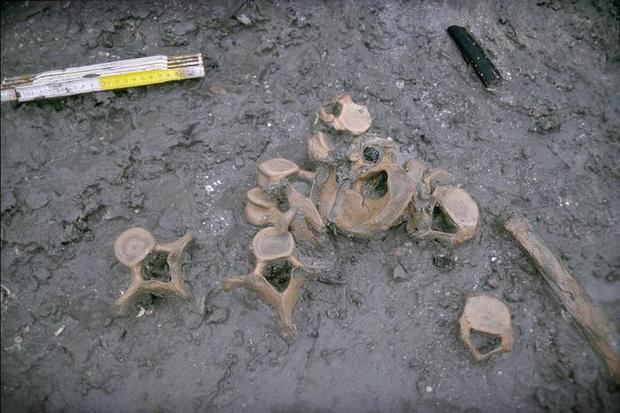DNA from 10,000-year-old "chewing gum" sheds light on teens' Stone Age menu and oral health: "It must have hurt"
DNA from a type of "chewing gum" used by teenagers in Sweden 10,000 years ago is shedding new light on the Stone Age diet and oral health, researchers said Tuesday.
The wads of gum are made of pieces of birch bark pitch, a tar-like black resin, and are combined with saliva, with teeth marks clearly visible.
They were found 30 years ago next to bones at the 9,700-year-old Huseby Klev archaeological site north of Sweden's western city of Gothenburg, one of the country's oldest sites for human fossils.
The hunter-gatherers most likely chewed the resin "to be used as glue" to assemble tools and weapons, said Anders Gotherstrom, co-author of a study published in the journal Scientific Reports.
"This is a most likely hypothesis -- they could of course have been chewed just because they liked them or because they thought that they had some medicinal purpose," he told AFP.
The gum was typically chewed by both male and female adolescents.
"There were several chewing gum (samples) and both males and females chewed them. Most of them seem to have been chewed by teenagers," Gotherstrom said. "There was some kind of age to it."
A previous 2019 study of the wads of gum mapped the genetic profile of the individuals who had chewed it.
This time, Gotherstrom and his team of paleontologists at Stockholm University were able to determine, again from the DNA found in the gum, that the teenagers' Stone Age diet included deer, trout and hazelnuts.
Traces of apple, duck and fox were also detected.
"If we do a human bone then we'll get human DNA. We can do teeth and then we'll get a little bit more. But here we'll get DNA from what they had been chewing previously," Gotherstrom said. "You cannot get that in any other way."
Identifying the different species mixed in the DNA was challenging, according to Dr. Andrés Aravena, a scientist at Istanbul University who spent a lot of time on the computer analyzing the data.
"We had to apply several computational heavy analytical tools to single out the different species and organisms. All the tools we needed were not ready to be applied to ancient DNA; but much of our time was spent on adjusting them so that we could apply them", Aravena said in a statement.
The scientists also found at least one of the teens had serious oral health issues. In one piece chewed by a teenage girl, researchers found "a number of bacteria indicating a severe case of periodontitis," a severe gum infection.
"She would probably start to lose her teeth shortly after chewing this chewing gum. It must have hurt as well," said Gotherstrom.
"You have the imprint from the teenager's mouth who chewed it thousands of years ago. If you want to put some kind of a philosophical layer into it, for us it connects artefacts, the DNA and humans," he said.
In 2019, scientists constructed an image of a woman based on the DNA extracted from 5,700-year-old chewing gum. She likely had dark skin, brown hair and blue eyes, and hailed from Syltholm on Lolland, a Danish island in the Baltic Sea. Researchers nicknamed the woman "Lola."
Researchers at the time said it was the first time an entire ancient human genome had been obtained from anything other than human bone.
Sophie Lewis contributed to this report.





